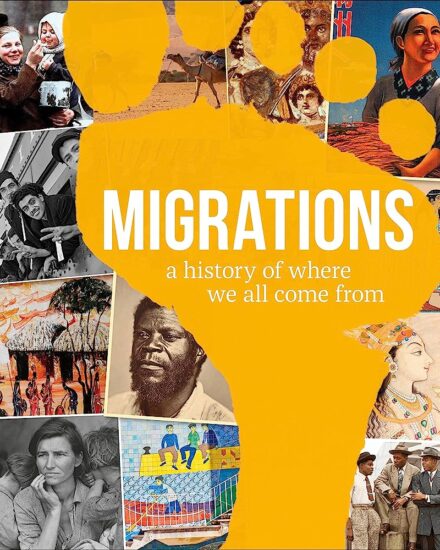Book Review: Migrations – a history of where we all come from
Dorling Kindersley, a Penguin Random House Company, London, 2022, 287 pages
Dorling Kindersley, the education and lifestyle publisher, has assembled a dozen contributors with relevant backgrounds to compile this attractive and comprehensive, albeit concise, survey of world migration history. It includes forced migration from 1900 onwards, which is about one-third of the book. It’s an attractive book due to its extensive illustrative content of maps, photos, sculpture, art and epigrams, and may be derided as a coffee table book. Yet its importance is as an authoritative and accessible introduction for most lay audiences, both young and adult, who seek an alternative to the long and detailed texts aimed at academic and specialist readers – surely a major contribution in this period of much toxic nativism and racism.
In his Foreword, Professor David Olusoga, a prominent British-Nigerian historian and broadcaster/film-maker, notes that migration is one of the biggest human stories, another reason why the book might interest the general public as well as elevate its understanding; Trove lists it as available in 52 Australian public libraries, which is considerable access. The ‘history of the world’ theme appeals to general curiosity: I can see adults sitting with kids or secondary students and having good conversations about the humanised stories they see on the page.
The six book sections begin with prehistory: The First Migrations, followed by Ancient Empires, Transcontinental Contact, Colonisation and Conquest, Mass Movement and Freedoms, and the post-1900 period mentioned above, Decolonisation and Conquest. The early sections cover 8 to 19 issues in about 500 words each, allocating a double page spread to each issue. The visuals rather than text dominate the space, but they are sumptuous and tell a story as well as generate questions. The recent period covers many more issues (about 35) than the previous five, so one reason why specialists might keep the book nearby is to fill gaps in their knowledge of localised refugee events from a quick yet expert source. Don’t expect depth, this is about breadth, and about history, including religion, imperialism, settler-indigenous conflict, slavery; the Refugee Convention only gets a single comment.
Modern refugee or migration issues covered in this double-page format include the Greece-Turkey population exchange of the early 1920s, Indochina refugees, South Asian workers in the Gulf, Central and South American crises, the aftermath of WW1, refugees from Bolshevism, Dust Bowl emigrants in the US, digital nomadism and migrant remittances, post-USSR emigration, the Windrush generation in the UK’s politics, the Indonesian transmigrasi program, the Lebanese diaspora, Nansen passports, the expulsion of South Asians from Uganda in the early 1970s, the Jewish homeland, the partition of India, Tibetans in exile, the evacuation of Jewish children from The Continent in the years prior to 1940, Palestinian migration, intra-African migration in the 1960s, climate migration issues for low-lying Pacific Islands, and a dozen or so other issues.
The publisher has another publication due in July 2023 called “Asylum Speakers: stories of migration from the humans behind the headlines” which is a collection of 31 stories of migration, based on podcasts which can be currently accessed here.
Kevin Bain’s Refugee Reading Guide is at Bayside Refugee Support. It has short summaries of about 100 books published over the last 20 years.

